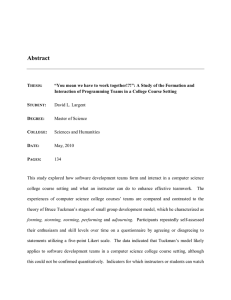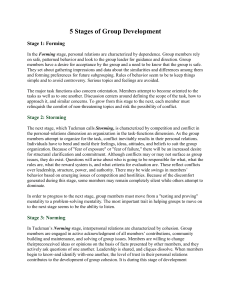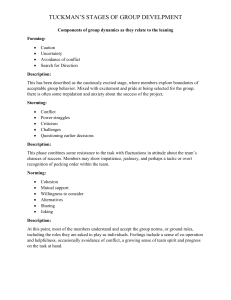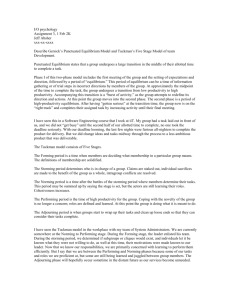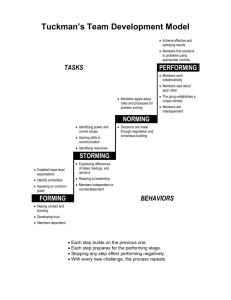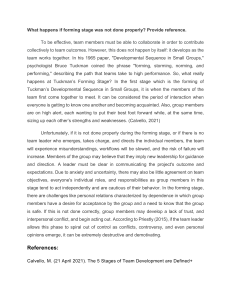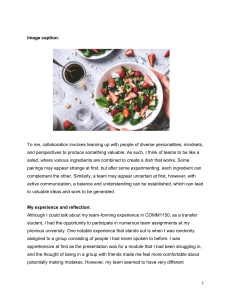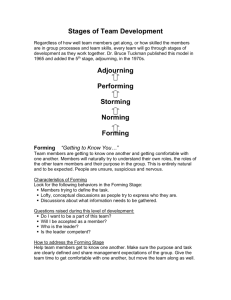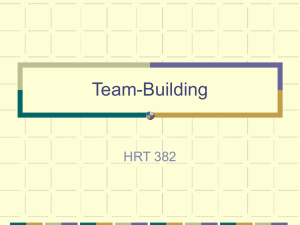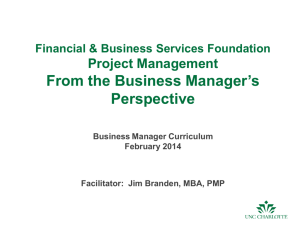Basic Group Theory: Tuckman's Five Stages of Group Development
advertisement
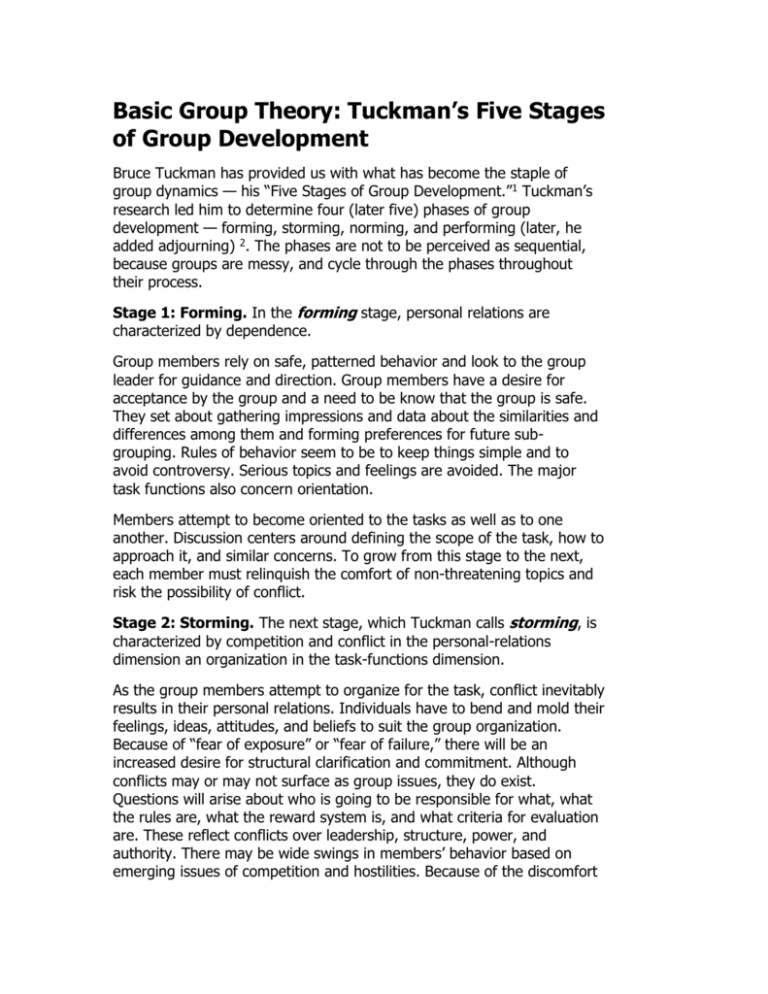
Basic Group Theory: Tuckman’s Five Stages of Group Development Bruce Tuckman has provided us with what has become the staple of group dynamics — his “Five Stages of Group Development.”1 Tuckman’s research led him to determine four (later five) phases of group development — forming, storming, norming, and performing (later, he added adjourning) 2. The phases are not to be perceived as sequential, because groups are messy, and cycle through the phases throughout their process. Stage 1: Forming. In the forming stage, personal relations are characterized by dependence. Group members rely on safe, patterned behavior and look to the group leader for guidance and direction. Group members have a desire for acceptance by the group and a need to be know that the group is safe. They set about gathering impressions and data about the similarities and differences among them and forming preferences for future subgrouping. Rules of behavior seem to be to keep things simple and to avoid controversy. Serious topics and feelings are avoided. The major task functions also concern orientation. Members attempt to become oriented to the tasks as well as to one another. Discussion centers around defining the scope of the task, how to approach it, and similar concerns. To grow from this stage to the next, each member must relinquish the comfort of non-threatening topics and risk the possibility of conflict. Stage 2: Storming. The next stage, which Tuckman calls storming, is characterized by competition and conflict in the personal-relations dimension an organization in the task-functions dimension. As the group members attempt to organize for the task, conflict inevitably results in their personal relations. Individuals have to bend and mold their feelings, ideas, attitudes, and beliefs to suit the group organization. Because of “fear of exposure” or “fear of failure,” there will be an increased desire for structural clarification and commitment. Although conflicts may or may not surface as group issues, they do exist. Questions will arise about who is going to be responsible for what, what the rules are, what the reward system is, and what criteria for evaluation are. These reflect conflicts over leadership, structure, power, and authority. There may be wide swings in members’ behavior based on emerging issues of competition and hostilities. Because of the discomfort generated during this stage, some members may remain completely silent while others attempt to dominate. In order to progress to the next stage, group members must move from a “testing and proving” mentality to a problem-solving mentality. The most important trait in helping groups to move on to the next stage seems to be the ability to listen. Stage 3: Norming. In Tuckman’s norming stage, interpersonal relations are characterized by cohesion. Group members are engaged in active acknowledgment of all members’ contributions, community building and maintenance, and solving of group issues. Members are willing to change their preconceived ideas or opinions on the basis of facts presented by other members, and they actively ask questions of one another. Leadership is shared, and cliques dissolve. When members begin to know-and identify with-one another, the level of trust in their personal relations contributes to the development of group cohesion. It is during this stage of development (assuming the group gets this far) that people begin to experience a sense of group belonging and a feeling of relief as a result of resolving interpersonal conflicts. The major task function of stage three is the data flow between group members: They share feelings and ideas, solicit and give feedback to one another, and explore actions related to the task. Creativity is high. If this stage of data flow and cohesion is attained by the group members, their interactions are characterized by openness and sharing of information on both a personal and task level. They feel good about being part of an effective group. The major drawback of the norming stage is that members may begin to fear the inevitable future breakup of the group; they may resist change of any sort. Stage 4: Performing. The performing stage is not reached by all groups. If group members are able to evolve to stage four, their capacity, range, and depth of personal relations expand to true interdependence. In this stage, people can work independently, in subgroups, or as a total unit with equal facility. Their roles and authorities dynamically adjust to the changing needs of the group and individuals. Stage four is marked by interdependence in personal relations and problem solving in the realm of task functions. By now, the group should be most productive. Individual members have become self-assuring, and the need for group approval is past. Members are both highly task oriented and highly people oriented. There is unity: group identity is complete, group morale is high, and group loyalty is intense. The task function becomes genuine problem solving, leading toward optimal solutions and optimum group development. There is support for experimentation in solving problems and an emphasis on achievement. The overall goal is productivity through problem solving and work. Stage 5: Adjourning. Tuckman’s final stage, adjourning, involves the termination of task behaviors and disengagement from relationships. A planned conclusion usually includes recognition for participation and achievement and an opportunity for members to say personal goodbyes. Concluding a group can create some apprehension - in effect, a minor crisis. The termination of the group is a regressive movement from giving up control to giving up inclusion in the group. The most effective interventions in this stage are those that facilitate task termination and the disengagement process. Footnotes 1 You can retrace his footsteps in “Developmental Sequence in Small Groups,” Psychological Bulletin, 63, 384-399. 2 Adapted by George Mason University, Center for Service and Leadership, http://www.gmu.edu/student/csl/5stages.html. Citation: http://tep.uoregon.edu/resources/crmodel/strategies/basic_group_theory. html
